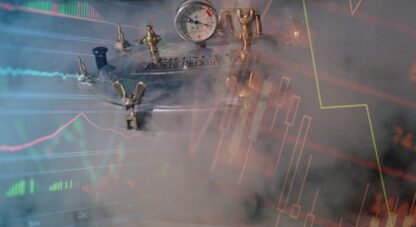An Object in Motion
In a week light on macroeconomic data and void of any Fed speakers, markets still adopted a decidedly defensive posture. The S&P 500 sold off by 3.37%, market breadth turned negative to the greatest extent since the start of the October equity rally, and each market sector outside of defensive utilities was lower on the week. In fact, of 100 subsectors outside of utilities, only two registered gains. Commodities were generally lower, with WTI crude leading declines with an 11.20% crash. The dollar bounced modestly, gold held steady above $1,800, and the recent bond surge retraced slightly as yields bounced.
This week’s market declines were no surprise. During the previous week, the sharp S&P 500 rally that kicked off in October hit significant technical resistance. Prices ran into the 200-day moving average, approached resistance at the 50-week moving average, and retreated from the bear-market downtrend line off the market peak that has halted every rally attempt of 2022. So, again, markets recoiling lower this week from last week’s encounter with key technical resistance levels was no surprise.
The real short-term test for markets will come next week. Market reaction to Tuesday’s November CPI report and Wednesday’s Federal Reserve FOMC policy meeting along with Powell’s post-FOMC press conference will likely reveal market direction into year-end. That said, the recessionary pig is already in the python and working its way through the system to ultimately be reflected in the strong likelihood of lower lows for markets in 2023.
The ongoing economic slowdown intensifying and turning recessionary is bad news for a structurally fragile, highly levered, debt-ridden financial system that works beautifully when liquidity is flowing in and asset prices are rising, but breaks mightily when the gears are slammed into reverse amid a vicious cycle of contraction, falling asset prices, and deleveraging.
In his 1951 article “Inflation Must End in a Slump,” Austrian economist Ludwig von Mises noted that all periods of government-induced credit expansion are ultimately unsustainable, and necessarily end in an economic crisis. As the premier voice of the Austrian School put it, “Economic theory has demonstrated in an irrefutable way that a prosperity created by an expansionist monetary and credit policy is illusory and must end in a slump, an economic crisis. It has happened again and again in the past, and it will happen in the future, too.” Mises’ timeless insight is correct, and on display in real time. Prosperity manufactured by unsound means is unsustainable.
In an attempt to perpetually fuel such an artificial prosperity, credit expansion and ample liquidity are needed. They are necessary to keep the music playing and the financial system dancing, but unsound and unsustainable arrangements ultimately unravel themselves. The Federal Reserve “band” adopted the singular focus of playing the tunes Wall Street demanded, but caused collateral damage in doing so. Financial markets decoupled from the real economy, financial asset bubbles were born, and inflation eventually escaped. As Mohamad El-Erian describes the arrangement, markets were “effectively holding central banks hostage and preventing them from ensuring the health of the economy as a whole.” With consumer-killing price inflation now unleashed, more credit expansion and ample liquidity will keep the inflation fire burning. As a result, expansionist monetary and credit policy has turned increasingly restrictive.
The asset bubbles that Fed policy created and nurtured pre-pandemic matured into super-inflated balloons courtesy of the additional unprecedented pandemic-response monetary and fiscal policy. The subsequent policy tightening and reduced levels of liquidity have now started to deflate the most egregious bubbles (think big tech, real estate, and the crypto-verse) embedded within the greater “everything” bubble. The question is, however, will the air now leaking out of the balloon stop there?
As Newton’s first law of motion instructs, an object in motion stays in motion. Our economy and financial system are now in motion, locked in a vicious cycle, and speeding toward danger. To borrow from Winston Churchill and expand a bit, “This is not the end [of this vicious process]. It is not even the beginning of the end. But it is perhaps the end of the beginning.” We are likely past the point where the momentum of this vicious cycle can be reversed without a significantly stimulative Fed policy pivot. Given the severely complicating factors of our hot inflationary backdrop and the Fed’s dire credibility issues, such a policy pivot can only be expected in the form of emergency response. A recession significant enough to somewhat reset inflation or a credit crisis, should it come first, is likely a necessary pre-condition for such a policy pivot.
As Bank of America chief investment strategist Michael Hartnett says matter-of-factly, “Bear markets end with a recession or an event that causes the Fed to reverse policy.” To date, markets have been hyper-focused on hopes for a non-recessionary soft-landing and a non-crisis pivot. Recently, however, some signs are finally emerging that markets are tuning in to reality and turning their focus from pivot myopia toward caution and concern over the negative “events” likely required to trigger such a pivot.
A classic indication of this shift of investor focus is on display in fixed income markets. Throughout 2022, in moves historically consistent with Fed rate hikes and inflation concerns, bonds tumbled and yields spiked. Lately, however, forward yields have declined significantly as bonds have surged. This recent price action is traditionally consistent with elevated growth concerns and the perceived need for a recession hedge.
Another indication of a growing uneasiness over recession fears can be seen in energy markets. Oil was the standout performer across all markets in the first half of this year. In the last six months, by contrast, WTI crude prices have dropped by 43%, including this week’s outsized double-digit drubbing. What provides the real recessionary whiff in the energy market air, however, is that the declines are persisting despite an array of incredibly bullish factors. Oil-specific geopolitical tensions are off the charts, inventories are extremely low, China is easing Covid-zero restrictions and heading toward a reopening, a price cap on Russian oil is causing Putin to threaten production cuts, a critically low US Strategic Petroleum Reserve will soon need to be replenished, OPEC+ recently cut production and is considering further cuts, and the cartel also claims no spare capacity. The easiest and best explanation for oil’s huge decline amid such an otherwise bullish context is that, at least for now, concerns over significant recessionary demand destruction have firmly taken hold as the dominant price-setting factor in the oil market.
Also of note, according to EPFR data, investors have exited global stocks at the fastest pace in five months, dumping $35 billion of exposure in just the last three weeks. At the same time, one of the more significant developing stories over the last week involves a building wave of investor redemptions in private investment funds.
As CoStar reported this week, “Investor calls to cash out shares are quickly spreading across U.S. nontraded real estate investment trusts, with more REITs taking steps to suspend or limit redemptions as economic concerns grow.” According to CoStar, at least three more REITs have disclosed moves to restrict investor cash redemptions since news broke late last week that the $69 billion Blackstone Real Estate Income Trust took such a step. These entities, not to be confused with publicly traded REITs, are highly levered, massive liquidity spigots flowing into the economy. With investors now fearing asset value markdowns and demanding redemptions as they run for the exits, however, the liquidity flow reverses, property purchase volumes fall, and the economy takes the hit.
Later this week, the redemption problem spread beyond commercial real estate as news surfaced of a second Blackstone fund that reached its 5% quarterly withdrawal limit. This time it was BCRED, a $50 billion private credit fund. This second Blackstone fund is another highly levered entity that invests in the debt of highly levered companies and in highly levered buyout deals. The BCRED private credit fund and other peer entities have become an important additional source of credit outside of the commercial banking system, the junk bond market, and the leveraged loan market. A disruption in private lending would further choke off access to capital and deliver another big hit to the economy, especially as the percentage of banks tightening their lending standards has already reached recessionary levels. Furthermore, with massive and reputable firms such as Blackstone halting redemptions, the risk is real and growing that halted redemptions at one fund trigger a “run” for redemptions at others. The ultimate impact of these unfolding developments is not yet known, but they could be extremely significant. They certainly bear close watching.
While some market participants are encouraged that Fed policy has started to deflate the super-sized bubbles in big tech, real estate, and the crypto-verse without fully crashing the economy and financial markets, recall that “an object in motion stays in motion.” A vicious cycle has taken hold, is in motion, and is just getting started. As former Treasury Secretary Larry Summers warned Bloomberg last week, the “economy could slide suddenly, like an avalanche.” If it does, and in 2023 the Fed is forced to unleash a premature stimulative policy pivot into still-elevated inflation, look to precious metals first and other commodities soon thereafter. In such a scenario, hard assets will shine bright.
Weekly performance: The S&P 500 lost 3.37%. Gold was little changed, up 0.06%, silver popped 2.02%, platinum added 0.94%, and palladium gained 3.53%. The HUI gold miners index was off 3.88%. The IFRA iShares US Infrastructure ETF was down 2.84%. Energy commodities were volatile and lower on the week. WTI crude oil was crushed by 11.20%, while natural gas was off 0.57%. The CRB Commodity Index was lower by 3.76%, while copper gained 0.78%. The Dow Jones US Specialty Real Estate Investment Trust Index was off 2.02% on the week, while the Vanguard Utilities ETF (VPU) was down 0.30%. The dollar was up 0.29% to close the week at 104.8. The yield on the 10-yr Treasury was up 6 bps, ending the week at 3.57%.
Best Regards,
Morgan Lewis
Investment Strategist & Co-Portfolio Manager
MWM LLC
















